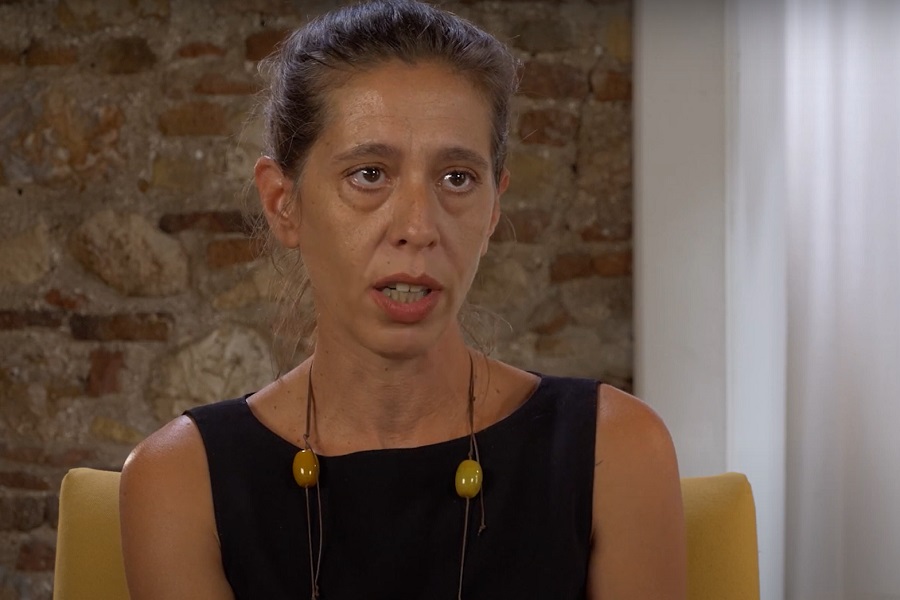Read below the announcement of Elia Charidi, Dr. of Social Anthropology, on behalf of Diotima Center in the presentation of the documentary ‘SAFEable’. Accessibility and Inclusion in Information and Protection from Gender-Based Violence”. The presentation was held on 10/12/2022, in Greek Film Archive.
Double form of oppression
“The existence of disability is often used in order for someone to feel more comfortable, perhaps to imagine a more harmless femininity, so as to be able to say something that is simultaneously oriented towards gender-based violence and towards ableism.”
This is how, one of the blind women who actively participated in the campaign and throughout the duration of the program “SAFEable Accessibility and Inclusion in Information and Protection from Gender-Based Violence” encapsulated the intersection of gender-based violence with disability. Social anthropologist, Raia Lignou, is moving towards a similar direction, as she argues that “the subject positions occupied by disabled ‘women’ are subject to a double, at least, form of oppression… at least double, because the experiences of disabled ‘women’ are differentiated both internally and in terms of gender, social class, age and sexuality” (2019: 157).
Interdisciplinary approach
The above is characteristic of the path Diotima Centre followed in its collaboration with liminal for the interdisciplinary exploration and presentation of gender-based violence in sensory disability. Taking into account, on the one hand, a feminist approach to gender-based violence and, on the other hand, the theorization of the social model for the social exclusion of disabled women, the main concern was to examine and consequently communicate – always in collaboration with sensory disabled women – the multiple exclusions, the complex normalizations and oppressions resulting from the power relations that are activated at the intersection of patriarchy with ableism.
At the same time, our concern was to identify the kind of care and attention required to protect disabled women from gender-based violence, without giving in to, but on the contrary, by weakening paternalistic and stereotypical discourses about the weakness, the tragedy and the individual responsibility of the disabled ‘victim’ of abuse.
Gaps in nstitutional level
This interdisciplinary approach to violence and the co-creation with disabled women have been essential for highlighting the multiple gaps that exist at a social and institutional level, both for the protection of disabled women from gender-based violence, and for their support in the case of abuse.
Some of the most important gaps are: 1) lack of accessible information on gender-based violence and related established rights, 2) lack of training on disability issues for the staff of services for abused women, and on gender-based violence issues for the staff of disabled people organizations and institutions, 3) non-accessible services for abused women, 4) difficulty in finding a job and, therefore, difficulty for a disabled woman to become financially autonomous and leave the abusive environment.
Sterotypes and obstavles
Various deep-rooted stereotypes consolidate and reproduce the above gaps, such as the one about the deviant or recessive femininity and sexuality of disabled women. Or the stereotype about their supposed inability to convey what has happened, so that they can make a complaint, for example, and be believed, or even be understood, as in the case where interpretation into Greek sign language is not available.
These obstacles, and the lack of trust, the intense hesitation, or even the fear that a disabled woman may feel to speak out, so as to receive the help she needs, was summed up by one of the blind participants in the discussion groups that took place as part of the project:
“If a woman says ‘well, I will use my next allowance for moving out, because I can’t stand it anymore, I want to live alone […] ‘, she may find no support at all. What I would like, for a woman with a sensory disability, is to find in every existing service or others that are being set up, […] a woman in charge who knows what to do with her. From the very simple things, knowing how to welcome, accompany, inform her, to knowing how to give her directions to find support. This does not exist. So […] I would more likely tell her, ‘Come stay at my home’, than send her somewhere where she will feel uncomfortable […] She has left a traumatizing environment. I don’t know if I could take the responsibility to re-traumatize her”.
Increased exposure of disabled women to violence
According to the international literature and some few studies that have been conducted on the relationship between gender-based violence and disability (see indicatively Mays 2006, Nixon 2009, Curry et al. 2011, Dalaka 2022), disabled women are more likely in their lifetime to experience violence or to live in an abusive relationship, where they may remain for a longer period of time.
The reasons for this increased exposure of disabled women to violence, as well as for the fact that a very small percentage decide to disclose it, are multiple and intricately connected.
Caregiver-abuser
In addition to the aforementioned reasons, a particularly important role is also attributed to the fact that: 1) the abuser is often the partner / spouse who undertakes daily duties of personal care and assistance (the duties of a caregiver / personal assistant / escort / sign language interpreter), and 2) depending on the type of disability, a woman is more frequently exposed to medical settings and/or institutions, where staff often prove to be abusive.
As has been argued by social disability scholars, “the need for personal assistance [constitutes] a vulnerability to abuse.” However, “if a person has a legal right to services or the financial means to employ their own personal assistance, they will have more independent control and are less likely to experience abuse. It is a person’s social position that creates dependence and vulnerability, not a physical disability”. (Shakespeare in Calderbank 2000: 526). The class dimension in disability is rightly introduced into the complex of patriarchy and ableism, as poverty is one of the key parameters of trapping disabled women in gender-based violence (Balderston 2013).
There are also other factors, that could be introduced on a case-by-case basis, and further complicate the intersectional approach to gender-based violence in disability (e.g., ethnicity and migration, age, (single) parenthood, and so on). Considering that disabled women often experience different forms of gender-based violence related to their type of disability, the issue here is to see and support the disabled and gender-abused body and subject, in its specific experiences and needs, as they emerge in the midst of the power, normalization and oppression relations that weave the system of ableism and patriarchy, very often along with racism, capitalism, and so on.
Supporting disabled women
According to public anthropology theories, a “campaign of social change” can be successful if it reveals “the patterns of action and knowledge construction and […] the normative assumptions that drive ideology” (Besteman 2013: 5). In the case of gender-based violence in disability, it is necessary to understand that it is not disability that makes a woman more vulnerable to violence, but that women “who need assistance with care and are reliant to some degree on others, are in a vulnerable position” that could lead to abuse, whether it occurs in the private or public space (Calderbank 2000: 521). The campaigns do not always lead to immediate changes in socio-politics, but operate on the basis of long-term visions. We hope, therefore, that with this effort, and future ones, we will «contribute to shifting the frame of perception, altering the discourse, or expanding the range of the possible” (Besteman 2013: 5), regarding what the experiences of disabled women survivors of gender-based violence may be and how they can be supported with due safety and dignity, without being re-victimized and re-traumatized.
Bibliography
Balderston, Susie 2013. «Victimized again? Intersectionality and Injustice in Disabled Women’s Lives after Hate Crime and Rape». Gendered violence: Macro and micro settings. Advances in Gender Research 18A: 17 – 51.
Besteman, Catherine 2013. «Three Reflections on Public Anthropology». Anthropology Today 29(6): 3 – 6.
Calderbank, Rosemary 2000. «Abuse and Disabled People: Vulnerability or Social Indifference? ». Disability & Society 15(3): 521 – 534.
Curry, Mary Ann, Paula Renker, Susan Robinson-Whelen, Rosemary B. Hughes, Paul Swank, Mary Oschwald, and Laurie E. Powers 2011. «Facilitators and Barriers to Disclosing Abuse Among Women with Disabilities». Violence and Victims 26(4): 430 – 444.
Mays, Jennifer M. 2006. «Feminist Disability Theory: Domestic Violence against Women with a Disability». Disability & Society 21(2): 147 – 58.
Nixon, Jennifer 2009. «Domestic Violence and Women with Disabilities: Locating the Issue on the Periphery of Social Movements». Disability & Society 24(1): 77 – 89.
Dalaka, Helen 2022. “Violence against Women with Disabilities: Concepts, Institutions, Policies”. Social Policy 16: 59 – 75 (in Greek)
Lignou, Raia 2019. “Both Disabled and Women (…)”. In Community Course on Intersectionality. Athens: Feminist Autonomous Center for Research (in Greek).





